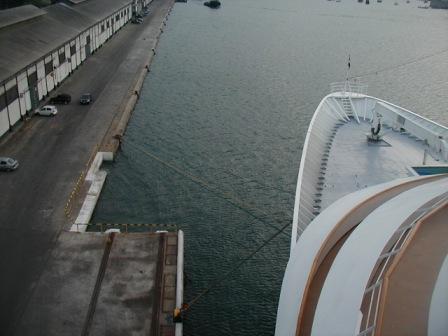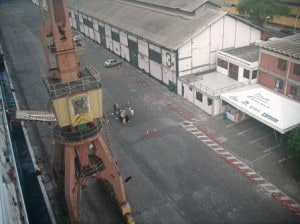As the name says the city of Salvador is located on the rim of a large bay which is basically a combined estuary of several rivers. The bay is quite sheltered and thus there are always numerous ships at the anchorage. Today was nearly full moon and that meant that there was a lot of current running out of the bay as we were arriving half way between high and low tide. This was clearly visible as we saw the eddy’s swirling at the entrance of the bay which is relatively deep in the middle but very shallow at each side. For this reason the pilots also board inside the bay. It is not much fun to sit in a pilot boat with swirling waters around you and so they avoid it. I estimated that we had close to four knots of current running against us. Not a big problem but it does slow you down.
The nice thing about the port in Salvador is the very large inner breakwater opening. It is about 1200 feet wide and regardless of wind and current, you can make a nice wide approach to the dock. We had to come through the north entrance as the south entrance is very shallow and can only be used during high to very high water. We were coming in on the out going tide and thus that option was not available so we were assigned to berth nbr 3 which by looking at the tents outside the building is the assigned cruise terminal. This was about half way down the pier and thus I could keep the speed up and sail through the breakwater with about 10 knots and then stopped the engines and float to a stand still at just about the right location.
 The head lines running forward and the breast lines going side ways. The little red circles near the bollards are Rat-shields, a compulsory remainder from the old days when all the docks would be infested by rats.
The head lines running forward and the breast lines going side ways. The little red circles near the bollards are Rat-shields, a compulsory remainder from the old days when all the docks would be infested by rats.
That is normally the easy part of docking; the hard work are the final inches, to get all the break doors in the right position and the dock fenders properly positioned along the rubbing stroke. Here comes the whole team into play. The chief officer is directing the handing out of the ropes and the officers fore and aft with their sailors have to put the ropes ashore in such away that they will hold the ship alongside in the most perfect way. In the mean time I have to try to keep the ship alongside the dock and as steady as possible in relation to the most perfect position.
Once the ropes are ashore, normally one spring line (the ships line leading forward) and one breast line (a line almost perpendicular to the ship) both fore and aft, then it is time to ask the gangway if the line up is perfect for their setup. For this purpose our security officer Mr. Sajith stands in the break door and counts us down when coming in and after I have the ship brought to a standstill, he verifies the final position and checks if the other break doors (for provisions, bunkers etc) are not obstructed by bollards or other shore side obstacles. The better the chief officer orchestrates this team work, the faster we can get the gangway out and the officials onboard for clearing the ship.
 The shore gangway, electric crane and the entrance to the cruise terimnal.
The shore gangway, electric crane and the entrance to the cruise terimnal.
Today we used a shore side gangway due to the tidal difference of about 12 feet and we just parked opposite to the cruise terminal entrance. The gangway was hooked in by a shore crane with was interesting to watch. First of all as it went very fast for Salvador standards; secondly as the crane was pushed in position with a tractor. Then a big electric plug came out of a cabinet and that was plugged into a socket in the dock floor. A process normally fraught with problems but today went very smoothly. The ship was docked at exactly 9 am and by 9.10 they had the gangway in position and the ship was cleared. Fast work from the authorities as well.
The ship stayed here until 11 pm partly because it is a slow run to Recife and partly because Salvador is the best and safest city to go out in the evening. The old city is full of little restaurants and a lot of them have live music. I hope that the guests took advantage of it, as Holland America always plans a few evening stops during each long cruise and these are there to be enjoyed.
When we sailed we had to leave the same way as we did coming in as it was now low water slack tide and that meant that the southern entrance/exit was too shallow. Thus we swung around off the dock, helped by a nice little breeze that pushed on the funnel. That breeze was the result of the warm day that we had and it produced enough of a thermal flow that just before sunset we had wind force 5 blowing. By 11pm it start to taper off again but there was still enough to help the ship swing around a bit faster. We had two pilots onboard but they were quite happy to just observe the proceedings and inspect the coffee machine. Just outside the inner port entrance they left already and I had the sincere impression that they had a party to attend somewhere. Good for me though as I could speed up directly now and sail without having to slow down for pilot transfer later on. Tomorrow will be another day at sea and we will arrive at Recife sometime before 8 am in the morning the day after tomorrow.

March 3, 2010 at 3:52 pm
As always, a very interesting blog. I enjoy your descriptions of the technical aspects as well as your wry wit. I also appreciate your discussions about ports – it helps me decide about future cruises. Thanks also for the great pictures.
March 3, 2010 at 7:47 pm
You describe a lot of hard work that goes into a smooth and safe docking. About the Costa Europa/old Westerdam accident, do you know which authority is responsible for investigating? I only know the aviation field’s investigation process…
March 4, 2010 at 11:22 am
I think for the Costa Europa, it will be mainly the Italian Maritime authority as the ship flew the Italian flag; they will no doubt want to know what the decision making process of the captain was. Then there might be a civil court investigation as three people died in the tragedy. Also the Egyptian authorities will have an investigation as there must have been an Egyptian pilot on board, plus they will want to have somebody pay for the damage to their pier. How this all will take place is diffcult to say as each country has its own maritime tradition in dealing with shipping disasters. I think we will see a lot of announcements in the press in the coming months.
Best regards
Captain Albert.
March 3, 2010 at 8:02 pm
What a cruise, what an excitement this cruise is. I enjoyed reading your blogs every day and I hope that one day you will decide to publish a book with your adventures as a cruise ship captain.
In your blogs you elaborate much about weather, winds, currents and also about docking operations in ports. I now understand why these things are so important for you as captain of a cruise ship. You have the responsibility for the health and lives of so many people. I had to think about all your stories when I was reading about the accident with the Costa Europa in Sharm el-sheik.
The ship was blown hard against the pier during docking. The hull was damaged and three sailors died. Some passengers were injured and had to go to hospital. The Costa Europa was the former old Westerdam from HAL. I wish you and the Prinsendam a save and sound cruise (Dutch : Behouden vaart) and hope that the weather don’t give you too much problems.